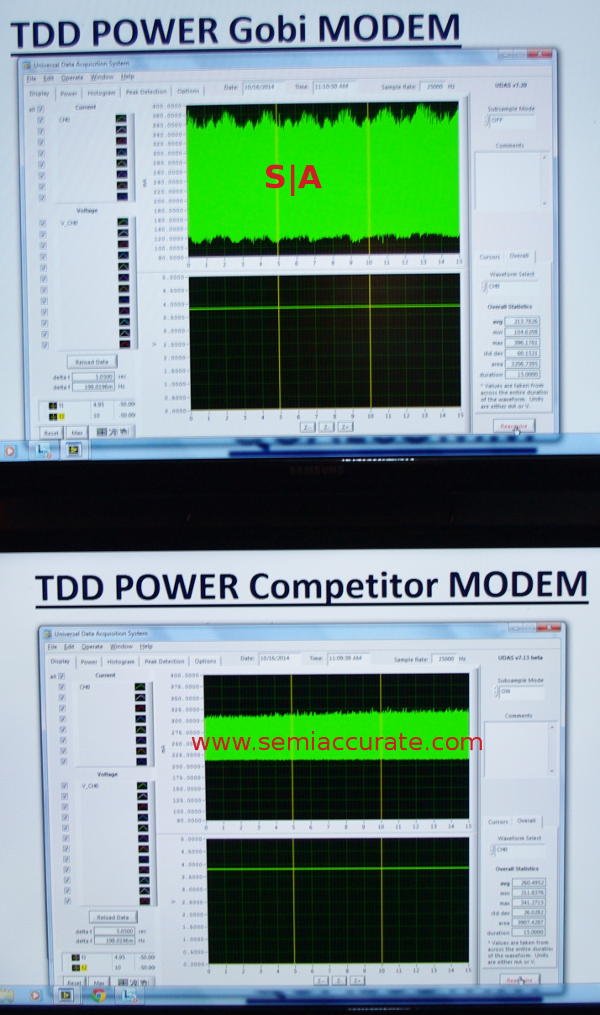 Qualcomm was showing SemiAccurate a few modem demos the other day on LTE power and throughput. In case you haven’t guessed where this is going, Qualcomm was showing off each of their component advantages individually.
Qualcomm was showing SemiAccurate a few modem demos the other day on LTE power and throughput. In case you haven’t guessed where this is going, Qualcomm was showing off each of their component advantages individually.
All of this was in concert with the 4K demos that Qualcomm was showing off a few weeks ago including their 4K dongle, 3-carrier aggregation, and 60GHz 802.11ad radio. This last set of demos was peeling apart of the individual pieces of radio performance, something that most users can’t see individually. They included TDD power, FDD power, and throughput/errors in transmissions. TDD and FDD were simple power readings, throughput was a 4K stream demo, and all were using devices in Cat 4 mode.

Transmission power levels for a 90/10Mbps send/receive stream
The idea is pretty simple, take a device and send a data stream to a receiver, measure the power used while doing this and voila, you get the graphs above. Almost like magic it shows you what was used, aren’t computers almost like magic? OK it is hard to make a power demo seem cool nowadays but I do try. These graphs may look a bit out of line but if you can see the fine print there are some interesting bits.
Qualcomm on top looks to have a wider range of absolute power use and indeed it does with a range between 120 and 360mV. The competitor modem is much tighter in the 210 to 305mV range but the averages are what count. Those are 213mV for Qualcomm and 260 for the competition, almost 20% worse for the unnamed guys. This says that Qualcomm among other things is much better at getting to low power states and staying there, ramping up as high as needed but only when needed. This is a good thing.
On the FDD side the story was similar but we will spare you the eye chart level graphs. Once again Qualcomm had a wider power range but a lower average draw. In this case Qualcomm used 209mV versus the unnamed opponent with a 286mV pull. This is a significant difference and both of these figures do translate into a lot longer standby and use time for Qualcomm.
There was a last demo that used a similar setup but instead of measuring power it just output a 4K video stream like the 802.11ad demo linked above. Both started off playing the same video at the same time and of course the Qualcomm one played smoothly. That couldn’t be said for the competition, it dropped frames, audio stuttered, and even paused the stream for several seconds at a time. It wasn’t pretty and that is the point but there were no frame counters or much else so we can’t quantify how bad it was. By the time the video was two minutes or so in the competitor was many seconds behind in playback.
One thing we are kind of surprised that Qualcomm did was run the three tests individually. They are all useful and nice to see pulled apart from each other but ironically they would have much more impact as a single demo. If you can run a 4K stream and measure TDD/FDD power separately, you would effectively compound the competition’s problems for a greater win. Better yet it is a totally valid number, not a PR inspired adding of disparate factors to look better. Total power used to stream a video is a real world use case if there ever was one. I guess the next demo they show off will have larger margins of victory and ironically it will be through a more relevant benchmark.S|A
Charlie Demerjian
Latest posts by Charlie Demerjian (see all)
- Qualcomm Is Cheating On Their Snapdragon X Elite/Pro Benchmarks - Apr 24, 2024
- What is Qualcomm’s Purwa/X Pro SoC? - Apr 19, 2024
- Intel Announces their NXE: 5000 High NA EUV Tool - Apr 18, 2024
- AMD outs MI300 plans… sort of - Apr 11, 2024
- Qualcomm is planning a lot of Nuvia/X-Elite announcements - Mar 25, 2024